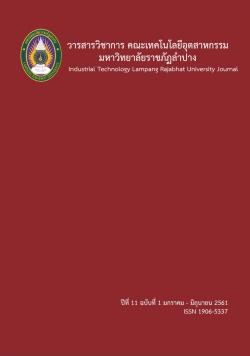Design and Construction of Cowboy Hat Drill Part Machine : A Case Study of Cowboy Hat Production Group
Keywords:
Design and Construction, Cowboy Hat, EfficiencyAbstract
This innovation project aims to design and construct a drilling machine for making cowboy hats as well as defining the efficiency of the drilling machine. The design of the most important structures are: the drilling cowboy hat machine, the hydraulic plate press, the hydraulic cylinder, the motor, the hydraulic oil tank, the hydraulic column support, the control valve, and the drill mold. The results showed that the manual labour on the perforation of the hats was 0.39 minutes per piece, the operation of the drill bit was 0.19 minutes per piece, giving a reduction in the drilling time on average of 0.2 minutes per piece and an average improvement of drill efficacy of 51.28%. The operation punching holes in the hats had an average labor time of 2.20 minutes per piece, the operation of the drill bit per piece averaged 0.44 minutes per piece, giving a reduced drill average time of 1.76 minutes per part and an increased drill efficiency average of 80%. The operation to pierce the hat averaged 2.57 minutes per piece, the perforation operation with the drill machine averaged 0.39 minutes per piece, with a reduction in drill time average of 2.18 minutes per part and an increased drill efficiency average of 84.82%.
References
Prombunmar, P. (2013). Design and Construction of Palm Leaf Separation Machine. Industrial Technology LampangRajabhat University Journal, 6(2), 24–34.
Pormputtisiri, N., (2002). Study on Influence of Die Clearance on Wear Behavior in Blanking Process. Retrieved January 27, 2017, fromhttp://www.thaithesis.org/detail.php?id=1947
Ravi, B., & Mukherjee, N.P. (2005). An integrated framework for die and mold cost estimation using design features and tooling parameter. Retrieved January 29, 2017, from http:www.//rd.springer.com/article/10.1007/s00170-004-2084-9
Strategy and Information Development Group. (2014). Development Plan for Lampang Province, 2014 – 2017. Retrieved January 23, 2017, from http://www.lampang.go.th/stragegic/index7.html
Sumpayakorn, C., Sawatdisup P., & Prasertworanan V. (1997). Die Design. Bangkok: S.ASIA PRESS (1989) CO.,LTD. (in Thai)
Tonchewawong, N., (2003). Hydraulic System. Bangkok: Technology Promotion Association (Thailand-Japan) Publisher. (in Thai)
Ungbhakorn, V. & Thanadngarn, C., (2001). Machine Design. Bangkok: Se-ed Publisher. (in Thai)
Wantang, T., Junchaipum, H., & Tierkatum, S. (2015). The Design and Production of a Stamping-Die Used toManufacture Souvenir Key-chains. Industrial Technology LampangRajabhat University Journal, 8(1), 24–33.






